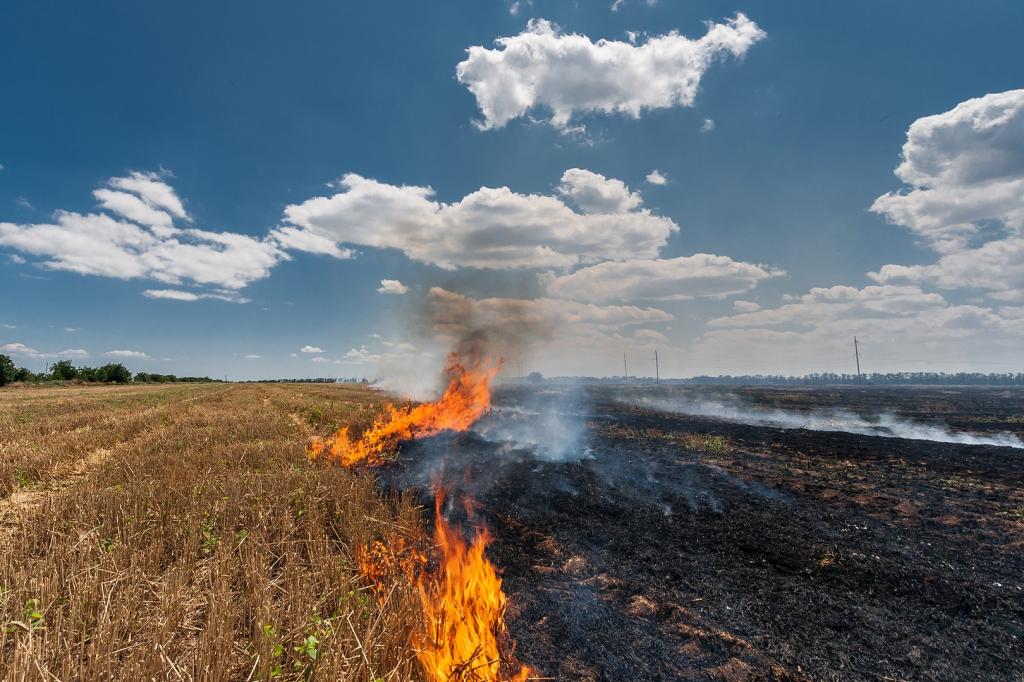

Although the actual amount of fines charged was not available; farmers continue to burn residues every season



Crop residue burning in Punjab, Haryana and western Uttar Pradesh has been known, but nowadays it's spreading more frequently in other parts of country.
Wheat stubble burning is a relatively new issue which started with mechanised harvesting using combine harvesters. In the last four to five years, farmers from UP’s Ghazipur district, especially Zamania and Chandauli areas, have been burning wheat stubble at a large scale.
The government officials are not paying attention toward this. Ramnagina Kushwaha, a farmer from Zamania, Ghazipur, recently died in a field after being set ablaze while burning wheat stubble.
The state government has not implemented the National Policy for Management of Crop Residues to protect the parali (crop residue). On December 10, 2015, the National Green Tribunal (NGT) had banned crop residue burning in the states of Rajasthan, Uttar Pradesh, Haryana and Punjab.
Burning crop residue is a crime under Section 188 of the IPC and under the Air and Pollution Control Act of 1981. However, government’s implementation lacks strength.
The Delhi high court had also ordered against burning residues, while Punjab government imposed a penalty of Rs 73.2 lakh farmers in 2016 for burning of crop residue.
Although the actual amount of fines charged was not available; farmers continue to burn residues every season — this making both the soil and air poisonous.
In addition to wheat and paddy, sugarcane leaves are most commonly burnt. According to an official report, more than 500 million tonnes of parali (crop residues) is produced annually in the country, cereal crops (rice, wheat, maize and millets) account for 70 per cent of the total crop residue.
Of this, 34 per cent comes from rice and 22 per cent from wheat crops, most of which is burnt on the farm. According to an estimate, 20 million tonnes of rice stubble is produced every year in Punjab alone, 80 per cent of which is burnt.
Instead of burning of the stubble, it can be used in different ways like cattle feed, compost manure, roofing in rural areas, biomass energy, mushroom cultivation, packing materials, fuel, paper, bio-ethanol and industrial production, etc.
Environmental and health risk
A study estimates that crop residue burning released 149.24 million tonnes of carbon dioxide (CO2), over 9 million tonnes of carbon monoxide (CO), 0.25 million tonnes of oxides of sulphur (SOX), 1.28 million tonnes of particulate matter and 0.07 million tonnes of black carbon. These directly contribute to environmental pollution, and are also responsible for the haze in Delhi and melting of Himalayan glaciers.
The heat from burning paddy straw penetrates 1 centimetre into the soil, elevating the temperature to 33.8 to 42.2 degree Celsius. This kills the bacterial and fungal populations critical for a fertile soil.
Burning of crop residue causes damage to other micro-organisms present in the upper layer of the soil as well as its organic quality. Due to the loss of ‘friendly’ pests, the wrath of ‘enemy’ pests has increased and as a result, crops are more prone to disease. The solubility capacity of the upper layers of soil have also been reduced.
According to a report, one tonne stubble burning leads to a loss of 5.5 kilogram nitrogen, 2.3 kg phosphorus, 25 kg potassium and more than 1 kg of sulfur — all soil nutrients, besides organic carbon.
A study conducted by Vitull K Gupta, professor of medicine, Bathinda, in 2016, revealed that 84.5 per cent people were suffering from health problem due to increased incidence of smog. It found that 76.8 per cent people reported irritation in eyes, 44.8 per cent reported irritation in nose, and 45.5 per cent reported irritation in throat.
Cough or increase in cough was reported by 41.6 per cent people and 18.0 per cent reported wheezing. Another study by the Institute for Social and Economic Change, Bengaluru, estimated that people in rural Punjab spend Rs 7.6 crore every year on treatment for ailments caused by stubble burning.
Solutions to the burning problem
In 2014, the Union government released the National Policy for Management of Crop Residue. Since then, crop residue management has helped make the soil more fertile, thereby resulting in savings of Rs 2,000/hectare from the farmer’s manure cost.
Farmers can also manage crop residues effectively by employing agricultural machines like:
On other hand, these machines are too costly and the state governments should come forward and provide better subsidy so that farmer can afford these machines. Former Agriculture Minister Radha Mohan Singh had said that the government is providing subsidy at 50-80 per cent for crop residue management machinery.
A provision of Rs 1,151.80 crore for two years has been made under this scheme for states like Punjab, Haryana, Uttar Pradesh and the National Capital Region.
We are a voice to you; you have been a support to us. Together we build journalism that is independent, credible and fearless. You can further help us by making a donation. This will mean a lot for our ability to bring you news, perspectives and analysis from the ground so that we can make change together.

Comments are moderated and will be published only after the site moderator’s approval. Please use a genuine email ID and provide your name. Selected comments may also be used in the ‘Letters’ section of the Down To Earth print edition.